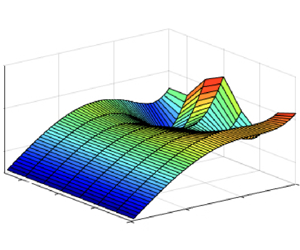Crossref Citations
This article has been cited by the following publications. This list is generated based on data provided by
Crossref.
Tang, Yong
Sun, Jinguo
Shi, Baolu
Li, Shuiqing
and
Yao, Qiang
2021.
Extension of flammability and stability limits of swirling premixed flames by AC powered gliding arc discharges.
Combustion and Flame,
Vol. 231,
Issue. ,
p.
111483.
2021.
Unsteady Combustor Physics.
p.
463.
Liu, Tengyu
Li, Jingxuan
Song, Yan
and
Yang, Lijun
2021.
A weakly nonlinear analytical model for the transversely forced flame describing function of a slit flame.
Fuel,
Vol. 292,
Issue. ,
p.
120247.
Vignat, Guillaume
Durox, Daniel
Renaud, Antoine
Lancien, Théa
Vicquelin, Ronan
and
Candel, Sébastien
2021.
Investigation of transient PVC dynamics in a strongly swirled spray flame using high speed planar laser imaging of SnO2 microparticles.
Combustion and Flame,
Vol. 225,
Issue. ,
p.
305.
Acharya, Vishal
and
Lieuwen, Timothy C.
2021.
Non-monotonic flame response behaviors in harmonically forced flames.
Proceedings of the Combustion Institute,
Vol. 38,
Issue. 4,
p.
6043.
Jiang, Xiaozhen
Yang, Lijun
Liu, Tengyu
and
Li, Jingxuan
2022.
Nonlinear Models of Laminar Premixed Slit Flame Responses Subjected to Two-Way Perturbations.
AIAA Journal,
Vol. 60,
Issue. 2,
p.
962.
Jiang, Xiaozhen
Li, Jingxuan
Yang, Lijun
and
Liu, Tengyu
2022.
A nonlinearly kinematic model of the asymmetrically turbulent premixed slit flame subjected to two-way harmonic disturbances.
Combustion and Flame,
Vol. 240,
Issue. ,
p.
112021.
Tian, Yu
Yang, Lijun
Morgans, Aimee S.
and
Li, Jingxuan
2023.
On the flame transfer function models for laminar premixed conical and V- flames considering the stretch effect.
Combustion and Flame,
Vol. 258,
Issue. ,
p.
113105.
Wu, Jiawei
Nan, Jiaqi
Yang, Lijun
and
Li, Jingxuan
2023.
Reconstruction of the flame nonlinear response using deep learning algorithms.
Physics of Fluids,
Vol. 35,
Issue. 1,
Xu, Bo
Li, Xinyan
Huang, Jiaqi
and
Wang, Ningfei
2024.
The effects of acoustic disturbances and mechanical vibration on laminar premixed flames: A comparative study.
Applied Energy,
Vol. 376,
Issue. ,
p.
124228.
Acharya, Vishal
2024.
Nonlinear global flame response behaviors for triggering of combustion instabilities.
International Journal of Spray and Combustion Dynamics,
Vol. 16,
Issue. 4,
p.
290.
Xu, Bo
Wang, Ningfei
Li, Guangxi
and
Li, Xinyan
2024.
Experimental investigation of the effect of mechanical vibration on the laminar premixed flame.
Physics of Fluids,
Vol. 36,
Issue. 8,
Liu, Tengyu
Wang, Pengcheng
Li, Jingxuan
Yang, Lijun
and
Ren, Zhuyin
2024.
Experimental investigation on the effects of transverse injection distribution scheme on dual flame dynamics subjected to flow disturbances.
Aerospace Science and Technology,
Vol. 147,
Issue. ,
p.
109003.
Patat, Clément
Blaisot, Jean-Bernard
Domingues, Éric
and
Baillot, Françoise
2025.
Response of n-Heptane and Dodecane Swirl-Stabilized Spray Flames to Transverse Forcing Characterized by Flame Describing Functions Based on Downstream Acoustic Pressure or Velocity Signals.
Journal of Engineering for Gas Turbines and Power,
Vol. 147,
Issue. 4,

 $m_{u}\neq 0$) can lead to non-zero unsteady heat release rate oscillations. The results show that for single frequency content (at
$m_{u}\neq 0$) can lead to non-zero unsteady heat release rate oscillations. The results show that for single frequency content (at  $\unicode[STIX]{x1D714}_{0}$), helical modes excite unsteady heat release rate response of
$\unicode[STIX]{x1D714}_{0}$), helical modes excite unsteady heat release rate response of  $O(\unicode[STIX]{x1D716}^{3})$ and that two-frequency excitation (e.g. at
$O(\unicode[STIX]{x1D716}^{3})$ and that two-frequency excitation (e.g. at  $\unicode[STIX]{x1D714}_{0}$ and
$\unicode[STIX]{x1D714}_{0}$ and  $2\unicode[STIX]{x1D714}_{0}$), leads to a response of
$2\unicode[STIX]{x1D714}_{0}$), leads to a response of  $O(\unicode[STIX]{x1D716}^{2})$ at
$O(\unicode[STIX]{x1D716}^{2})$ at  $\unicode[STIX]{x1D714}_{0}$. There are two mechanisms through which this can occur: First, helical flow disturbances can distort the time-averaged flame shape to have an azimuthal component that matches that of the incident disturbance,
$\unicode[STIX]{x1D714}_{0}$. There are two mechanisms through which this can occur: First, helical flow disturbances can distort the time-averaged flame shape to have an azimuthal component that matches that of the incident disturbance,  $\exp (im_{u}\unicode[STIX]{x1D703})$. Second, multiple helical modes can nonlinearly interact to cause axisymmetric unsteady flame wrinkling. The paper derives the various modal contributions in the incident velocity disturbance that satisfy these criteria. These results suggest that it is only the
$\exp (im_{u}\unicode[STIX]{x1D703})$. Second, multiple helical modes can nonlinearly interact to cause axisymmetric unsteady flame wrinkling. The paper derives the various modal contributions in the incident velocity disturbance that satisfy these criteria. These results suggest that it is only the  $m_{u}=0$ mode which controls the linear dynamics (e.g. instability inception conditions) of these flames (where
$m_{u}=0$ mode which controls the linear dynamics (e.g. instability inception conditions) of these flames (where  $\unicode[STIX]{x1D716}\ll 1$), but that their nonlinear dynamics is also controlled by the
$\unicode[STIX]{x1D716}\ll 1$), but that their nonlinear dynamics is also controlled by the  $m_{u}\neq 0$ helical modes.
$m_{u}\neq 0$ helical modes.